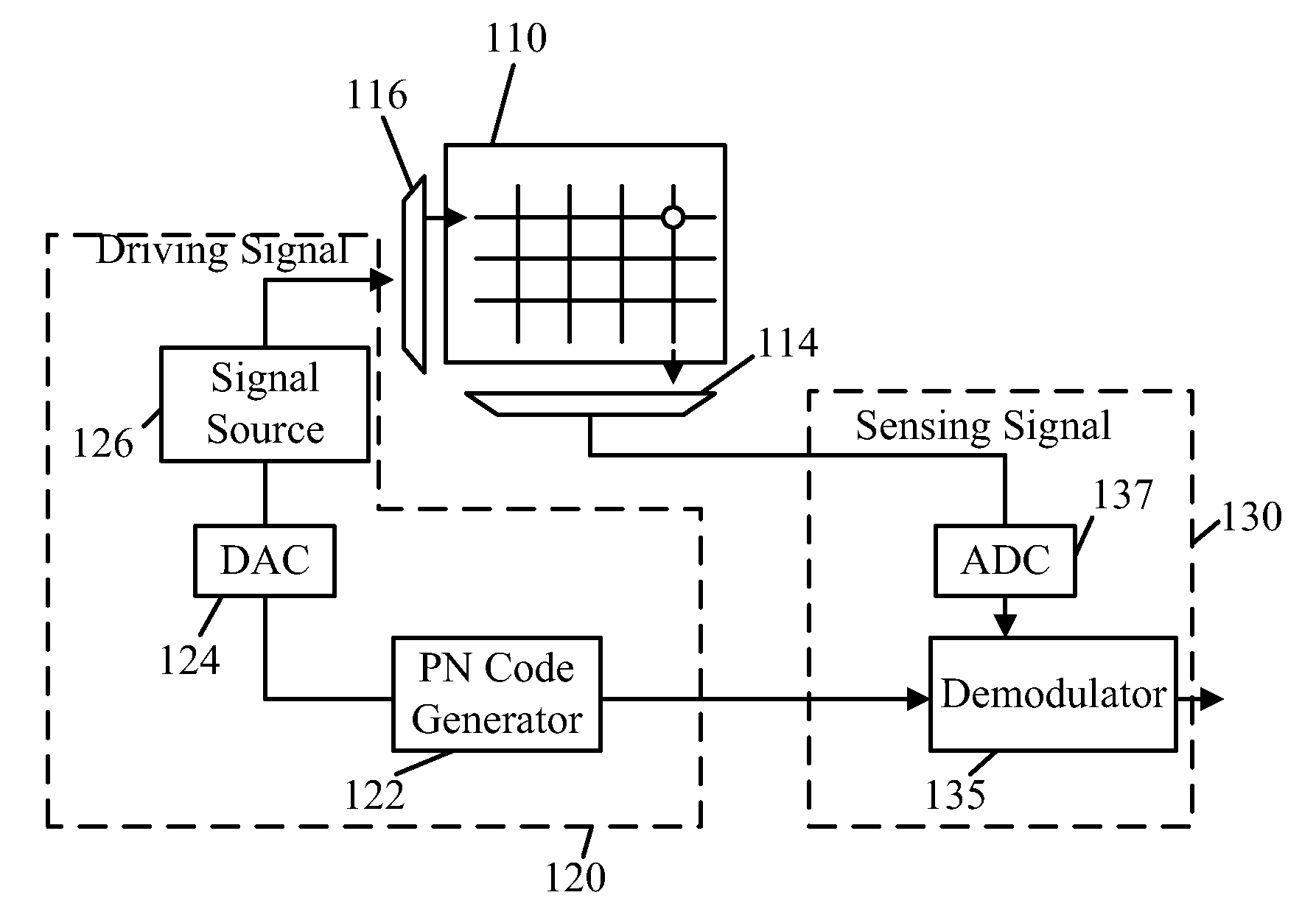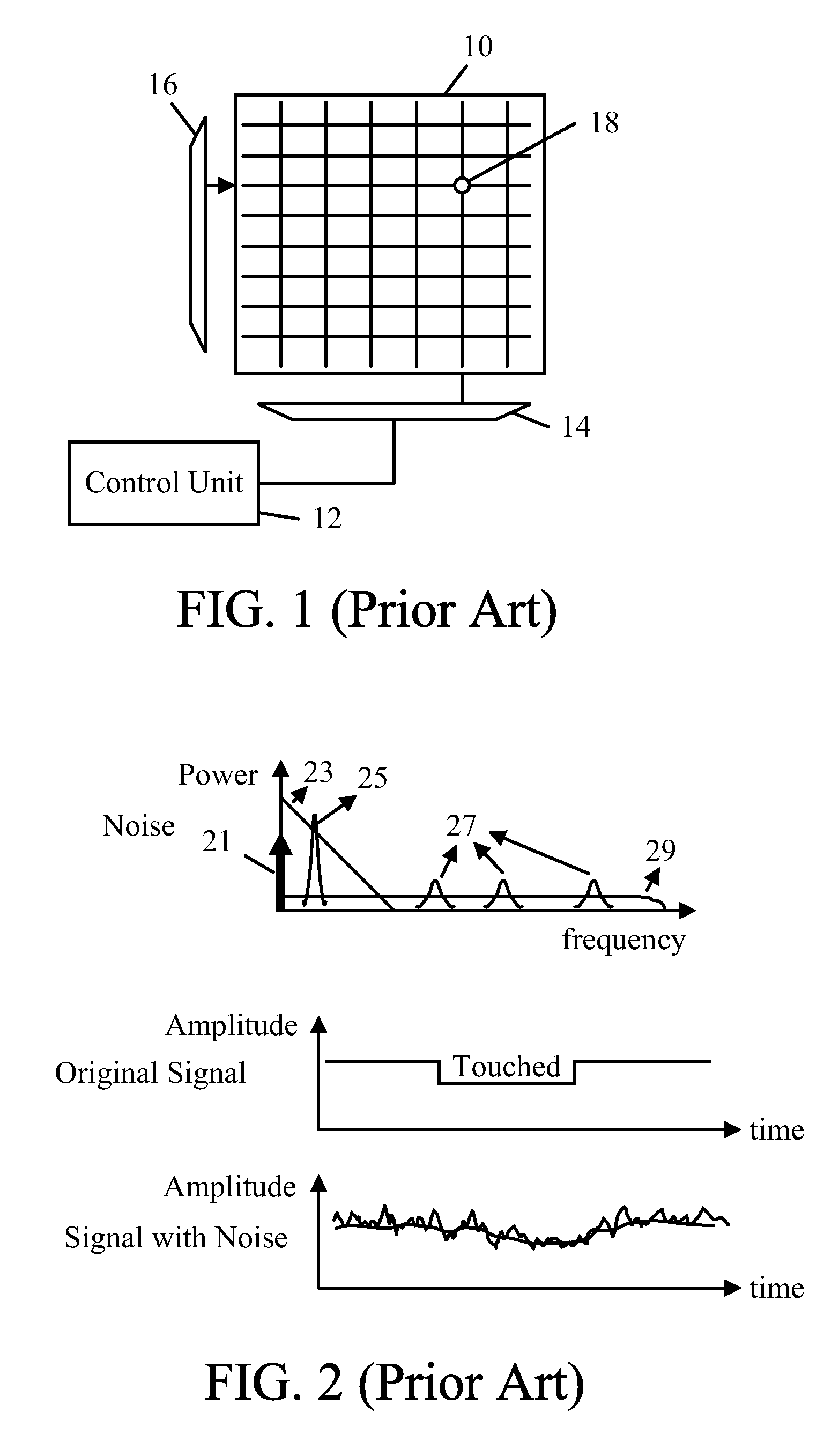Touch sensing apparatus and method
- Summary
- Abstract
- Description
- Claims
- Application Information
AI Technical Summary
Benefits of technology
Problems solved by technology
Method used
Image
Examples
first embodiment
[0036]FIG. 5 is a schematic diagram showing a touch sensing apparatus 100 in accordance with the present invention. The touch sensing apparatus 100 (e.g. a touch panel) includes a sensing array 110 having a number of conductors intersecting as columns and rows, each intersection (i.e. a node) is provided with a sensing element (not shown) such as a capacitor or a resistor. In the present embodiment, the touch sensing apparatus 100 includes a driving circuit 120 and a sensing circuit 130. The driving circuit 120 has a modulation signal generator, which is implemented by a PN code generator 122 in the present embodiment. The PN code generator 122 randomly generates a code as a modulation signal, which is digital. The code is converted into an analog code waveform by a digital-to-analog converter (DAC) 124. The analog code waveform is used to modulate a driving signal, which can be a voltage or current signal, provided by a signal source 126. The PN code modulated driving signal is sen...
third embodiment
[0043]FIG. 12 is a schematic diagram showing a touch sensing apparatus 300 in accordance with the present invention. In this embodiment, the sensing apparatus 300 is similar to the sensing apparatus 100 in FIG. 5. The only difference is that the modulation signal generator is implemented by a periodic wave generator (e.g. a square wave or sine wave generator) 322 in the present embodiment. It is noted that DAC and ADC are omitted herein for the sake of simplification. A periodic wave (e.g. square wave) provided by the periodic wave generator 322 is used as a modulation signal to modulate a voltage or current signal of a signal source 326 to generate a modulated driving signal to driving a row of a sensing array 310 through a multiplexer 316. A specific column is detected through a multiplexer 314 and a sensing signal of a node, which is the intersection of the driven row and the detected column, is obtained. The sensing signal is demodulated with the same periodic wave by a demodula...
fourth embodiment
[0045]FIG. 14 is a schematic diagram showing a touch sensing apparatus 400 in accordance with the present invention. The touch sensing apparatus 400 is similar to the touch sensing apparatus 200 in FIG. 10, except that the PN code generators are all replaced by periodic wave generators 432, 442, . . . , 492. The periodic wave generators 432, 442, . . . , 492 can be implemented by square wave generators or sine wave generators, for example. The periodic wave generators 432, 442, . . . , 492 respectively provide periodic waves (e.g. square waves or sine waves) of different frequencies f-1, f-2, . . . , f-n to modulate a signal provided by a signal source 426 so as to generate different driving signal for driving rows of a sensing array 410. It is preferred that the different frequencies are separated from each other by an interval of at least 10 kHz. The determination of the interval relates the time of measurement. The longer the time to measure a column is, the narrower the noise ba...
PUM
 Login to View More
Login to View More Abstract
Description
Claims
Application Information
 Login to View More
Login to View More - R&D
- Intellectual Property
- Life Sciences
- Materials
- Tech Scout
- Unparalleled Data Quality
- Higher Quality Content
- 60% Fewer Hallucinations
Browse by: Latest US Patents, China's latest patents, Technical Efficacy Thesaurus, Application Domain, Technology Topic, Popular Technical Reports.
© 2025 PatSnap. All rights reserved.Legal|Privacy policy|Modern Slavery Act Transparency Statement|Sitemap|About US| Contact US: help@patsnap.com



